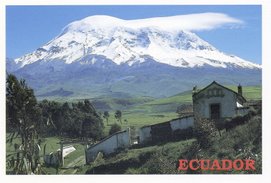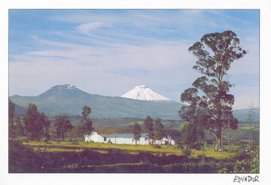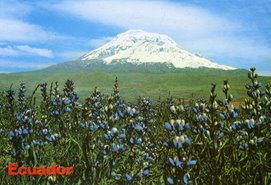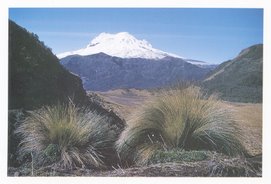At the start of this afternoon class, we had the opportunity to speak with japanese students who are in their country through video conference. This was an interesting experience because we could learn not only other English pronuntiations, but also other points of view and ideas about a specific topic: the balance between family and work.
I hope that we will have other opportunity to join this class because is unusual but enjoyable.
Thursday, July 12, 2007
Wednesday, June 20, 2007
'Earliest gunshot victim' found
One of the first people thought to have been killed by gunfire in the Americas has been found in a burial plot near Lima in Peru, scientists have said.
A skull bearing a gunshot hole was discovered amongst the remains of 72 bodies in a suburb of the capital.
Archaeologists believe the bodies were those of ancient Incas killed by Spanish conquistadors 500 years ago.
Forensics experts using a powerful scanning microscope later found fragments of metal on the skull.
"There may have been Incas and other native people killed by Europeans before him, but this is our oldest example so far," Peruvian archaeologist Guillermo Cock, who led the excavations in Lima, is quoted as saying by the Washington Post newspaper.
"We didn't expect it. We saw this skull and saw the almost round hole and thought people must have been shooting around here recently," Mr Cock, whose research is funded by National Geographic, said.
One of the forensics experts who analysed the skull said his team had tried to rule out all other possible causes of the hole, such as a rock from a slingshot, a spear or a sledgehammer.
"We all thought it was a million-to-one chance that we would find any traces of metal on a skull that old, but it was worth a try," said Al Harper, director of the Henry C Lee Institute of Forensic Science in West Haven, Connecticut, in the US.
Indigenous support
The skull is thought to have belonged to an Inca man who was involved in the 1536 siege of Lima.
The bodies seemed to have been buried hastily in shallow graves instead of being wrapped and put in the ground in the traditional Inca way.
"Some of the bodies also showed signs of terrible violence," Mr Cock said.
"They had been hacked, torn, impaled - injuries that looked as if they had been caused by iron weapons - and several had injuries on their heads and faces that looked as if they were caused by gunshots."
Mr Cock said the nature of the injuries found on the bodies - made with indigenous weapons such as stone axes and arrows - indicated that the conquistadors would have had some kind of native support to help in their conquest.
"That really confirms... native support for the conquerors was very important.
"The chronicles do not acknowledge the participation of the natives... [they] tell you that a couple of dozen cavalry men defeated the Inca troops in Lima."
A skull bearing a gunshot hole was discovered amongst the remains of 72 bodies in a suburb of the capital.
Archaeologists believe the bodies were those of ancient Incas killed by Spanish conquistadors 500 years ago.
Forensics experts using a powerful scanning microscope later found fragments of metal on the skull.
"There may have been Incas and other native people killed by Europeans before him, but this is our oldest example so far," Peruvian archaeologist Guillermo Cock, who led the excavations in Lima, is quoted as saying by the Washington Post newspaper.
"We didn't expect it. We saw this skull and saw the almost round hole and thought people must have been shooting around here recently," Mr Cock, whose research is funded by National Geographic, said.
One of the forensics experts who analysed the skull said his team had tried to rule out all other possible causes of the hole, such as a rock from a slingshot, a spear or a sledgehammer.
"We all thought it was a million-to-one chance that we would find any traces of metal on a skull that old, but it was worth a try," said Al Harper, director of the Henry C Lee Institute of Forensic Science in West Haven, Connecticut, in the US.
Indigenous support
The skull is thought to have belonged to an Inca man who was involved in the 1536 siege of Lima.
The bodies seemed to have been buried hastily in shallow graves instead of being wrapped and put in the ground in the traditional Inca way.
"Some of the bodies also showed signs of terrible violence," Mr Cock said.
"They had been hacked, torn, impaled - injuries that looked as if they had been caused by iron weapons - and several had injuries on their heads and faces that looked as if they were caused by gunshots."
Mr Cock said the nature of the injuries found on the bodies - made with indigenous weapons such as stone axes and arrows - indicated that the conquistadors would have had some kind of native support to help in their conquest.
"That really confirms... native support for the conquerors was very important.
"The chronicles do not acknowledge the participation of the natives... [they] tell you that a couple of dozen cavalry men defeated the Inca troops in Lima."
Monday, June 11, 2007
THE DAY OF DEATHS
In Ecuador on November 2 we celebrate the Day of Deaths, a holiday in which all people remember their relatives and friends who have died, and prepare a special meal of a sweet, hot drink composed of black corn flavour and fruits like blackberries, mortinos and strawberries, which is called "colada morada" (purple cream). This drink is accompanied by sweet and salt bread in doll's form.
On this occasion, families join together to go to cemeteries, bringing flowers for the deads' tombs. After that, they go to the parents' or other relatives' houses to share the special meal.
Some aboriginal families still eat their meals in the cemetery, because they think that is good to share the food with the dead.
In a small town near Quito, called Calderon, people make short figures of marzipan, that have different colours and are really beautiful and elaborate.
I enjoy the Day of Death a lot because I love the "colada morada". In fact, I am thinking to ask my mother if she can send me a container full of my favorite drink.
On this occasion, families join together to go to cemeteries, bringing flowers for the deads' tombs. After that, they go to the parents' or other relatives' houses to share the special meal.
Some aboriginal families still eat their meals in the cemetery, because they think that is good to share the food with the dead.
In a small town near Quito, called Calderon, people make short figures of marzipan, that have different colours and are really beautiful and elaborate.
I enjoy the Day of Death a lot because I love the "colada morada". In fact, I am thinking to ask my mother if she can send me a container full of my favorite drink.
Thursday, June 7, 2007
A REFLEXION ABOUT ENGLISH CLASSES
This is the second week of my third English course. I am registered to complete four courses, and for that I am in the second half of my English studies.
We have changed of teachers another time, this is a good practice because we can know varied forms of teaching and learn more from people who are from different places.
At this time, my level of comprehension of speaking and writing English has been developing, and my speaking too, but I am vey concerned about my writing, because in attention of my profession, I need to communicate by formal writing English with most of the people.
There are more new students in this course, and because of that we have had an important number of speaking activities that took most of the class time, less reading tasks and a few writing activities. I hope that the next weeks we will have other activities with less time each one, because if not, sometimes we can not do another things.
However, I am enjoying with the enthusiasm and good preparation that our teacher, Helen, has demostrated in the time that she is with us.
We have changed of teachers another time, this is a good practice because we can know varied forms of teaching and learn more from people who are from different places.
At this time, my level of comprehension of speaking and writing English has been developing, and my speaking too, but I am vey concerned about my writing, because in attention of my profession, I need to communicate by formal writing English with most of the people.
There are more new students in this course, and because of that we have had an important number of speaking activities that took most of the class time, less reading tasks and a few writing activities. I hope that the next weeks we will have other activities with less time each one, because if not, sometimes we can not do another things.
However, I am enjoying with the enthusiasm and good preparation that our teacher, Helen, has demostrated in the time that she is with us.
Wednesday, May 23, 2007
APPLE'S DELIGHT
Ingredients:
- Some apples
- a handful of raisins
- a little of butter
- some sugar
- some flour
- two eggs
Preparation:
Peel the apples and cut them in slices, then put them in a suitable container for oven, put too the raisins and the half of butter cut in short pieces; put it into the oven and bake at 180o for 10 minutes. Put off and incorporate the mass previously prepared with flour, eggs, sugar and the rest of butter. Put it into the oven again for 20 minutes. Wait that it is cold and eat it, is really delightly.
Sunday, May 13, 2007
A BEAUTIFUL COUNTRY NAMED ECUADOR
One of the smaller countries of the Andean republics, Ecuador, is one of the most beautiful and interesting countries too, not only for its magnificent geography but also for its people.
In the nort west of South America, between Colombia and Peru, Ecuador lies on the Pacific coast and is bisected by the Andes. It takes its name from the equator, the circle perpendicular to the earth's axis of rotation and equidistant from its poles, which divides the surface into northern and southern heminspheres. It runs through the northern part of the country, right near Quito, the capital city, wich is one of the highest cyties in the world.
An amazingly varied country, Ecuador boasts magnificent scenery, with lofty volcanoes proudly studding the two cordilleras that form the country's backbone. It also features: superb religious monuments that bear witness to the era of Spanish colonization; a huge, luxuriant forest that covers the lysterious Amazon region that seems to stretch endlessly into the distance; scores of picturesque little native villages, which, perched in the Andes, seem frozen in the time; and finally, of course, the extraordinary world of the Galapagos Islands.
Taken of Ecuador travel guide
Wednesday, May 2, 2007
LEARNING MORE...
Last holiday I went to the Adelaide's Art Gallery of South Australia, to see the special Egiptian Exhibition. It was amazing, because it was the first time I saw all the development that those people reached. I had heard about them but when I saw the writing, the cult of death and the rest of their legacy, I comprehended the high level of their culture.
Subscribe to:
Posts (Atom)



